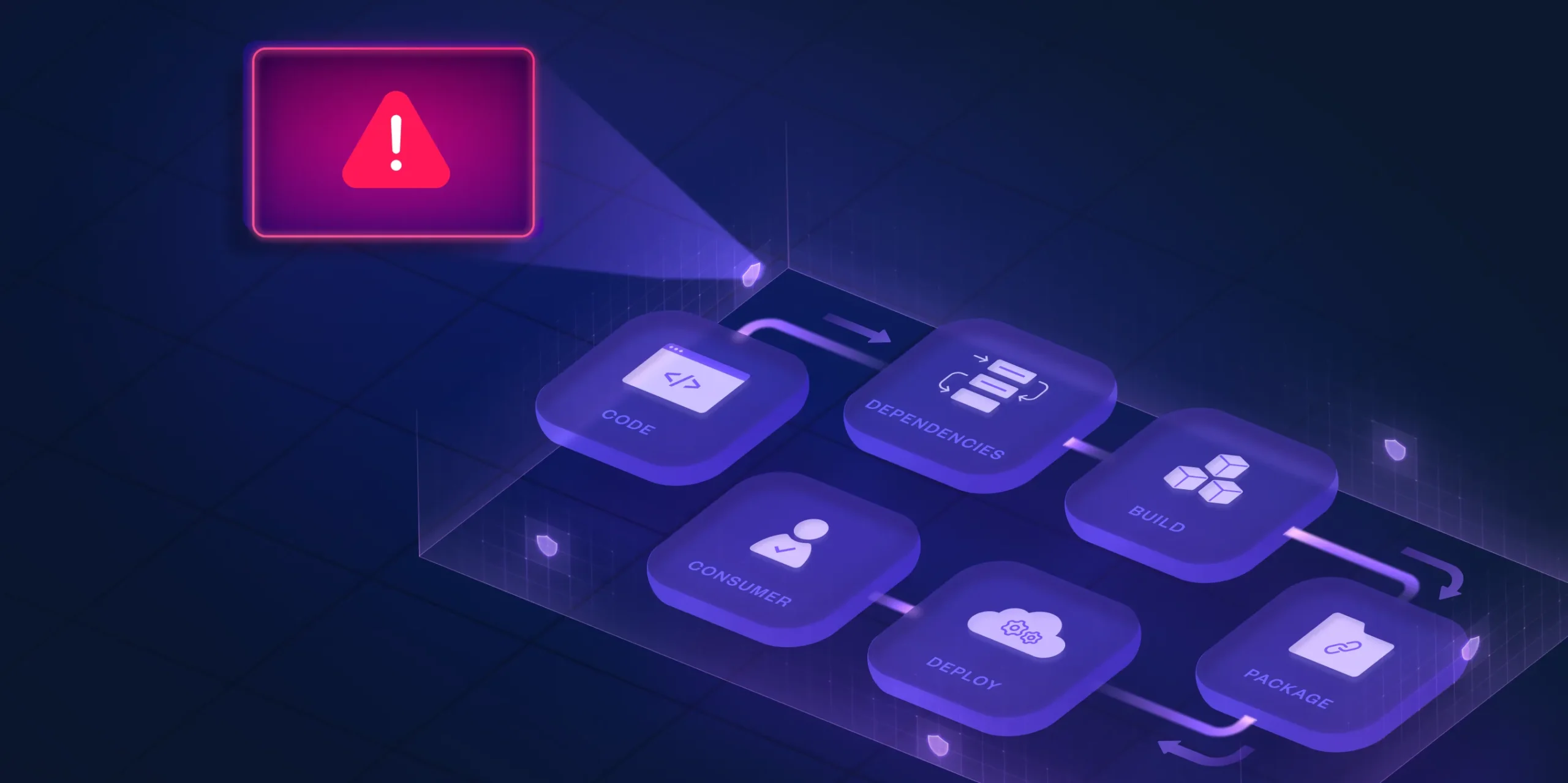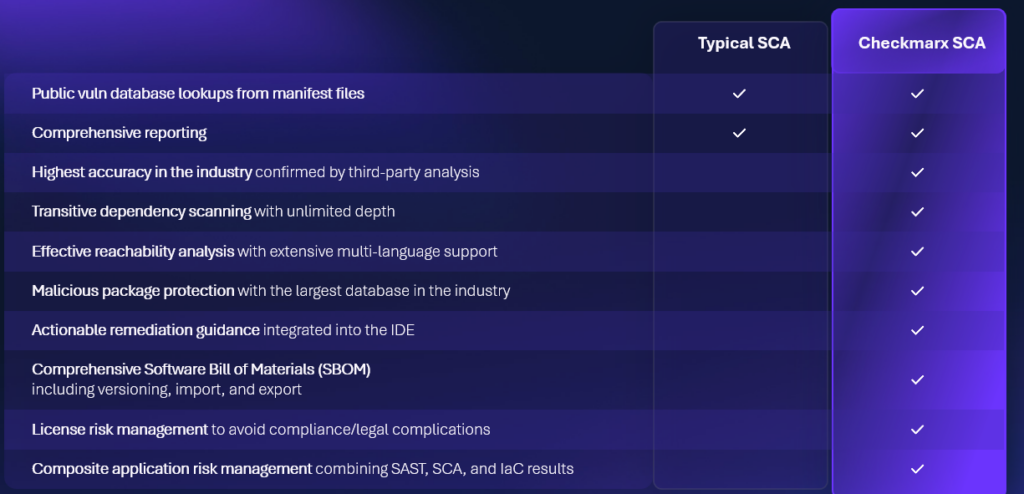
Summary
“SCA is an application security solution that identifies vulnerabilities and licensing issues in an application’s codebase, with a particular focus on its open-source components. Here’s how to choose the right SCA tool.”
What is SCA?
Software Composition Analysis (SCA) is an application security solution that identifies security risks and licensing issues in an application’s codebase, with a particular focus on its open-source software (OSS) components.
Why do enterprises need SCA? Modern development relies heavily on open-source code, which allows developers to build applications more efficiently. With open-source, they can reuse existing code instead of creating new solutions from scratch.
But while this accelerates development, it also introduces risks. Open-source code can have its own security flaws; any vulnerabilities in these open-source components can compromise the security of the entire application. In addition, bad actors can inject malicious code into open source packages.
SCA tools help mitigate these risks by automatically scanning and detecting vulnerable code and dependencies within an application’s codebase.
10 Required SCA Features
A top-tier SCA tool should offer a comprehensive suite of software composition analysis features that help enterprises ensure security while being developer-friendly. Here are the features that the best SCA tools should have:
1. Comprehensive Scanning
What: Code scanning is an automated process that analyzes source code to identify potential security vulnerabilities, coding errors, misconfigurations, and other weaknesses.
How: SCA solutions should scan codebases continuously and notify users in real-time when new vulnerabilities are discovered. Scanning is expected to include the core codebase, dependencies from both public and private package repositories and AI-generated code.
Why: This will help developers detect issues early in the software development lifecycle, reducing the risk of security breaches.
2. Software Vulnerability and Malware Detection
What: Software vulnerabilities are weaknesses or flaws in a program that arise from coding errors, design flaws, or misconfigurations. In addition, attackers can perform malicious activities on code, such as injecting malware (e.g., viruses or ransomware), inserting malicious scripts (e.g., cross-site scripting), or manipulating data flows to steal sensitive information (e.g., SQL injection).
How: SCA tools must detect known vulnerabilities or malicious malware and scripts in open-source libraries before they are used in the company’s codebase.
Why: This detection ensures attackers do not exploit these threats to bypass security controls, gain unauthorized access and disrupt operations.
3. Actionable Remediation Guidance
What: Guided remediation is the process of providing developers with step-by-step instructions or recommendations to fix identified vulnerabilities, preferably within their IDE.
How: The SCA tool should suggest updates, patches, or alternative libraries to mitigate them. Ideally, it should also provide context about each vulnerability’s exploitability (reachability), helping to prioritize the most important ones to remediate first.
Why: This helps ease, expedite and prioritize mitigation efforts to make sure developers are resolving the most important security issues in the most efficient manner.
4. License Risk Management
What: OSS licenses are legal agreements that dictate how software can be used, modified, and shared, specifying the permissions restrictions, and obligations for users and developers when utilizing open-source code.
How: SCA tools should detect these licenses (e.g., MIT, GPL, Apache) and flag potential legal risks and violations.
Why: Ensures awareness and tracking of all relevant third-party code license requirements and restrictions, to avoid potential compliance issues and other legal complications.
5. SBOM Generation
What: An SBOM (Software Bill of Materials) is a detailed inventory that lists all the components, libraries, and dependencies used in a software application. Generating an SBOM allows tracking all open-source components within an application so organizations can understand the scope of their open-source usage and manage associated risks.
How: SCA tools need to be able to generate an SBOM from their scanning results, which includes identifying direct and indirect dependencies of third-party libraries used by the applications. They should also be able import SBOMs to ensure that no software components are being overlooked.
Why: SBOMs allow organizations to quickly identify whether they are affected by a known vulnerability. This allows for prompt patching, mitigation, or removal of the compromised elements, reducing the window of exposure and minimizing the potential impact of an attack. Additionally, it helps in maintaining compliance with security policies and ensuring proactive monitoring of vulnerabilities in real-time.
6. Multiple Language Support
What: Enterprises and open-source projects use a mix of languages and frameworks to build complex systems, allowing for versatility, flexibility and scalability. SCA tools need to support a wide variety of programming languages and frameworks to be successful.
How: SCA tools need to be able to detect vulnerabilities in, and provide remediation guidance for, a wide range of programming languages, package managers, and ecosystems (e.g., Java, Python, JavaScript, Ruby, Go, etc.).
Why: This will ensure comprehensive vulnerability-detection coverage across the entire application.
7. Tight CI/CD and CLI Tool Integrations
What: Modern engineering organizations do not use tools in isolation. Rather, they streamline workflows as much as possible by connecting disparate tools with integrated workflows.
How: SCA tools should integrate with a wide variety of development and deployment tools and environments. This includes CI/CD pipelines, code repositories like GitHub, project management tools like Jira, ASPM solutions, and more.
Why: Integrations increase adoption and security success, since they automate processes and allow developers to address security issues within their familiar development environment.
8. Low False-Positive Rates
What: Developers are plagued with a high volume of irrelevant security alerts, which defocuses developers, creates noise and frustration, and impedes long-term adoption of security practices.
How: The SCA tool must offer accurate results with minimal false positives.
Why: Reducing false alarms allows developers to focus on real risks, making it easier to address vulnerabilities efficiently and ensuring that the tool becomes a welcome and integral part of the development workflow.
It also builds developer trust, ensuring that they follow the tool’s guidelines rather than disregarding them as “noise”. This way, both security and compliance goals are met without slowing down productivity.
9. Developer-Friendly Features
What: Tools that are designed with the developers in mind integrate into their workflows, give developers real-time alerts and actionable guidance and minimize false positives.
How: SCA tools need to seamlessly integrate into the tools, environments and workflows used by developers. They also need to ensure that alerts are accurate and focused on real threats and provide clear instructions for remediation.
Why: Developer adoption is crucial for an SCA tool to significantly improve an organization’s security and compliance. If developers don’t actively use the tool, its value is diminished.
10. Resources
What: Some security tools go beyond just identifying vulnerabilities by offering documentation, best practices, and training resources to help developers better understand the security implications of those risks.
How: The SCA vendor should offer comprehensive educational resources, like a blog, whitepapers, webinars, etc.
Why: By understanding why certain vulnerabilities matter and how they could be exploited, developers are more likely to adopt a security-first mindset. This proactive approach reduces long-term security debt and improves the overall resilience of the codebase. Additionally, providing these resources helps bridge the gap between security teams and developers, fostering a collaborative environment where security is integrated throughout the entire development lifecycle.
How Does Checkmarx SCA stacks up?
Checkmarx SCA emerges as a top contender for the best SCA tool due to its seamless integration within the Checkmarx One application security platform. This unique positioning delivers several key advantages:
- Industry-leading accuracy backed by third-party validation.
- Unlimited-depth transitive dependency scanning to uncover deep-rooted vulnerabilities.
- Robust reachability analysis across diverse languages for comprehensive coverage.
- Protection against malicious packages with the industry’s largest database.
- Actionable remediation guidance directly within the developer’s IDE for efficient fixes.
- Comprehensive SBOM capabilities for enhanced transparency and compliance.
- Proactive license risk management to prevent legal and compliance issues.
- Holistic view of application risk by combining SAST, SCA, and IaC results.

Request a free custom demo today and discover how it can elevate your organization’s application security posture.